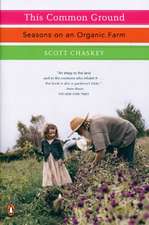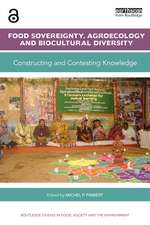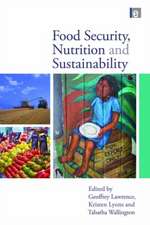The Economics of Managing Crop Diversity On-farm: Case studies from the Genetic Resources Policy Initiative: Issues in Agricultural Biodiversity
Editat de Edilegnaw Wale, Adam G. Drucker, Kerstin K. Zanderen Limba Engleză Paperback – 24 noi 2010
Preț: 320.13 lei
Preț vechi: 369.08 lei
-13% Nou
Puncte Express: 480
Preț estimativ în valută:
61.27€ • 63.72$ • 50.58£
61.27€ • 63.72$ • 50.58£
Carte tipărită la comandă
Livrare economică 14-28 aprilie
Preluare comenzi: 021 569.72.76
Specificații
ISBN-13: 9781849712224
ISBN-10: 1849712220
Pagini: 160
Ilustrații: Line Drawings, index
Dimensiuni: 156 x 234 x 233 mm
Greutate: 0.2 kg
Ediția:New.
Editura: Taylor & Francis
Colecția Routledge
Seria Issues in Agricultural Biodiversity
Locul publicării:Oxford, United Kingdom
ISBN-10: 1849712220
Pagini: 160
Ilustrații: Line Drawings, index
Dimensiuni: 156 x 234 x 233 mm
Greutate: 0.2 kg
Ediția:New.
Editura: Taylor & Francis
Colecția Routledge
Seria Issues in Agricultural Biodiversity
Locul publicării:Oxford, United Kingdom
Cuprins
PrefaceList of ContributorsPart I: Setting the Scene1. Introduction: Setting the Scene for GRPI EconomicsPart II: Variety Trait Preferences and On-Farm Conservation Policy2. Economic Analysis of Ethiopian Farmers' Preferences for Crop Variety Attributes: A Choice Experiment Approach3. Valuation of Rice Diversity in Nepal: A Trait-based Approach4. Farmers' Perceptions on Replacement and Loss of Traditional Crop Varieties: Examples from Ethiopia and ImplicationsPart III: Market Value Chains, Commercialization and On-farm Conservation Policy5. Consumers' Attribute Preferences and Traders' Challenges Affecting the Use of Local Maize and Groundnut Varieties in Lusaka: Implications for Crop Diversity Policy6. Commercialization and Market Linkages for Promoting the Use of Local Rice Varieties: A Nepalese Case StudyPart IV: Conclusions and Outlook7. Findings, Conclusions, Implications and OutlookIndex
Notă biografică
Edilegnaw Wale is a Senior Lecturer in the Department of Agricultural Economics, School of Agricultural Sciences and Agribusiness, University of KwaZulu-Natal, Pietermaritzburg, South Africa.Adam G. Drucker is a Senior Economist at Bioversity International, Rome, Italy. Kerstin K. Zander is a Research Fellow in the School for Environmental Research, Charles Darwin University, Darwin, Australia.
Recenzii
'The book by Wale and collaborators helps to enlighten us about the deep rooted causes of agro-biodiversity loss. A very valuable addition to the libraries of policy makers, scientists and environmental and development NGOs concerned with this global problem.'Dr. Unai Pascual, Lecturer, Department of Land Economy, Cambridge'Based on the Genetic Resources Policy Initiative (GRPI), which aims to strengthen the capacity of developing countries to design comprehensive policy frameworks for genetic resources, this book aims to document the range of economic issues of relevance to agro-biodiversity policy. In so doing, it succeeds to link results based on scientific, in this case economic, work to policy recommendations and thereby contributing to both the scientific as well as the policy discussion. Its major contribution to the scientific discussion is the application of various economic approaches (e.g., choice experiments, hedonic pricing, variety attribute preference ranking, contingent valuation and farm business income analysis) to empirically analyze the value chains of plant genetic resources used in food production. In that way the multi-dimensions of in situ conservation become better understood and it is easier to integrate in situ conservation policies into rural development interventions to address potential policy trade-offs. The enhanced economic understanding of the decision processes enables the improved design of well targeted conservation policies for both the traditional varieties well marketable (de facto conserved) and the threatened varieties, which need clear (financial) compensatory measures to be maintained by the farmers. By doing so, the book takes forward the policy discussion to make the conservation of plant genetic resources (used in food production) part of the broader rural development agenda.'Dr. Detlef Virchow, Food Security Center (FSC), University of Hohenheim, Germany

























